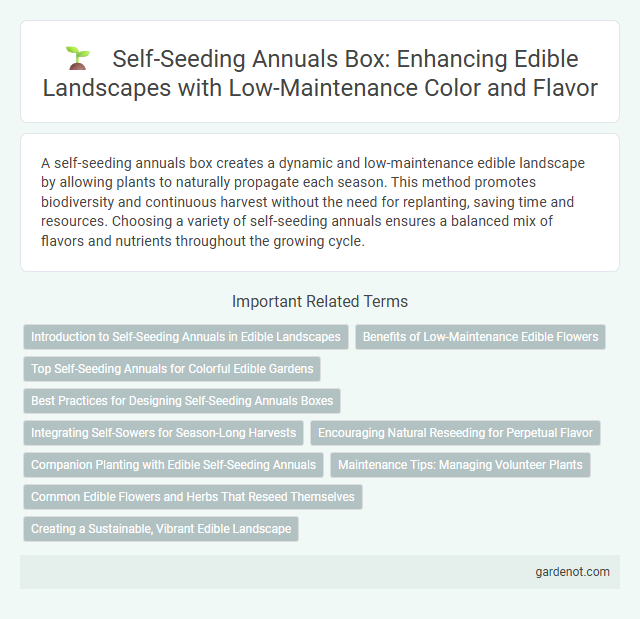A self-seeding annuals box creates a dynamic and low-maintenance edible landscape by allowing plants to naturally propagate each season. This method promotes biodiversity and continuous harvest without the need for replanting, saving time and resources. Choosing a variety of self-seeding annuals ensures a balanced mix of flavors and nutrients throughout the growing cycle.
Introduction to Self-Seeding Annuals in Edible Landscapes
Self-seeding annuals are plants that complete their life cycle in one growing season and naturally disperse seeds for new growth the following year, making them ideal for sustainable edible landscapes. Popular examples include calendula, nigella, and borage, which provide both aesthetic appeal and edible benefits without replanting efforts. Incorporating self-seeding annuals enhances biodiversity, supports pollinators, and ensures continual harvests with minimal maintenance.
Benefits of Low-Maintenance Edible Flowers
Self-seeding annuals in an edible landscape provide continuous blooms with minimal effort, reducing the need for replanting each season. These flowers attract pollinators, enhancing fruit and vegetable yields while adding vibrant colors to garden beds. Their natural reseeding ability supports sustainable gardening by conserving resources and promoting biodiversity.
Top Self-Seeding Annuals for Colorful Edible Gardens
Top self-seeding annuals for colorful edible gardens include nasturtiums, calendula, and borage, renowned for vibrant blooms and edible petals. These plants require minimal maintenance, naturally reseeding to ensure continuous color and harvest year after year. Incorporating self-seeding annuals enhances biodiversity while providing fresh, edible flowers that attract pollinators and enrich garden aesthetics.
Best Practices for Designing Self-Seeding Annuals Boxes
Designing self-seeding annuals boxes requires selecting hardy species like cosmos, calendula, and nigella that thrive with minimal intervention and reseed reliably each season. Utilize well-draining soil enriched with organic matter to support vigorous growth and ensure proper spacing to prevent overcrowding, which promotes air circulation and reduces disease risk. Incorporate companion plants to enhance biodiversity and monitor moisture levels closely to balance hydration without waterlogging, optimizing the sustainability of your edible landscape.
Integrating Self-Sowers for Season-Long Harvests
Integrating self-seeding annuals such as nasturtiums, sunflowers, and calendula into your edible landscape ensures a continuous, low-maintenance harvest throughout the growing season. These self-sowers naturally drop seeds that germinate the following year, reducing replanting efforts while enhancing biodiversity. By strategically placing these plants in designated boxes, gardeners can enjoy a thriving, sustainable garden that offers fresh produce from spring through fall.
Encouraging Natural Reseeding for Perpetual Flavor
Self-seeding annuals box promotes natural reseeding by allowing plants like basil, cilantro, and nasturtiums to drop seeds directly into nutrient-rich soil, ensuring continuous growth and perpetual flavor without replanting. This method enhances biodiversity and soil health while reducing the need for manual sowing, making edible landscapes more sustainable and low-maintenance. Encouraging natural reseeding supports year-round harvests, maximizing fresh, homegrown ingredients for culinary use.
Companion Planting with Edible Self-Seeding Annuals
Companion planting with edible self-seeding annuals enhances garden productivity by naturally replenishing crops like arugula, nasturtiums, and coriander, which attract beneficial insects and improve soil health. These annuals create a resilient ecosystem by reducing the need for replanting and supporting nutrient cycling, making them ideal for sustainable edible landscapes. Integrating self-seeding annuals with compatible plants ensures continuous harvests and pest control through natural biodiversity.
Maintenance Tips: Managing Volunteer Plants
Self-seeding annuals in an edible landscape box require careful management to prevent overcrowding and ensure healthy growth. Regularly thin volunteer plants by selectively removing weaker seedlings to maintain adequate spacing and airflow. Mulching around established plants helps suppress unwanted seedlings while conserving moisture and improving soil health.
Common Edible Flowers and Herbs That Reseed Themselves
Common edible flowers and herbs that reseed themselves, such as nasturtiums, calendula, borage, and coriander, create low-maintenance self-seeding annuals boxes that provide continuous harvests year after year. These plants thrive in sunny locations with well-drained soil and naturally drop seeds to establish new growth without replanting. Incorporating self-seeding edible flowers and herbs enhances biodiversity, attracts pollinators, and offers both culinary and ornamental benefits in an edible landscape.
Creating a Sustainable, Vibrant Edible Landscape
Self-seeding annuals boxes promote sustainability by naturally regenerating plants each season, reducing the need for replanting and external inputs. These vibrant edible landscapes support biodiversity, improve soil health, and provide continuous harvests of nutrient-rich greens, herbs, and vegetables. Integrating self-seeding annuals enhances resilience and productivity, making your edible garden eco-friendly and low-maintenance.
Self-seeding annuals box Infographic

 gardenot.com
gardenot.com